In my point of view, this is a MUST-READ for every presenter, just copy some Amazon users’ comment here.
“Imagine that you are preparing to give the most important presentation of your life. For a week prior to the event you will be sequestered on a desert island then picked up by the cruise ship where you will make your presentation. You are informed about your audience and provided with information on the meeting room environment. However, you may only take one book with you to prepare. I recommend 100 Things Every Presenter Needs to Know About People by Susan M. Weinschenk, Ph.D. This book does an excellent job in delivering a concise, compendium of what you need to know.
As a presentation geek, I have read many of the leading authors, such as Nancy Duarte, Garr Reynolds, Bert Decker and many others. They are all strong in their own right. In comparison, Dr. Weinschenk’s book gets right to the point on each of the 100 things without taking more than two or three pages to get there. It brings together a wide range of material in a small package.
The book is divided into ten sections, ranging from how people learn, getting and keeping people’s attention, motivating action, listening and visual guides, environment concerns, emotion, reaction, decision-making, and crafting your prez and a 90-day improvement plan.
In each of the 100 mini-chapters, you learn how to use psychology to be a better presenter. In a pinch, you could take the handy takeaways included in each chapter as a cheat sheet reminder.
The book consolidates sometimes hard-to-find resources such as those for determining what font size to use, depending on screen size and the distance your viewers will be from the screen. You may learn research about things you thought you knew. Did you know that if your audience reads from left to right, the correct side of the screen to stand on is the left side, that is, your audience’s left? You want to be the first thing your audience sees as they scan the room. Did you know that people use peripheral vision more than central vision to get the gist of your slide? It goes back to our ancestor’s days on the savannah when it was critical to scan for predators.
As though the rich collection of psychological guidance weren’t enough, the next to the last section of the book is a guide to actually crafting your presentation. It helps you analyze your audience, determine where they are, where you want them to be and how to get them there by outlining or storyboarding a meaningful structure.
Think that you wouldn’t be interested in this book if you are not doing a lot of presentations? Many of these principles can be used in situations where you are sitting in a conference room with ten people, across the desk at a job interview or in a virtual meeting. Training developers will also find very helpful information about how adults learn and designing more effective training presentation materials.
Do yourself and your next audience a favor. Buy this book, read it, study it, build your own cheat sheets from it, then enjoy the improved results from your presentations, large or small.”
Buy it here:
or download it here: [showhide more_text=”View Download Link” less_text=”Hide Download Link”]
http://go.nguyenhoangminh.info/100-things-for-presenter
[/showhide]
Happy Reading


